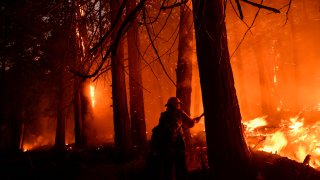
Santa Cruz County is in for a grim fire season.
That was the assessment of Cal Fire San Mateo-Santa Cruz Unit Chief Nate Armstrong, who gave a presentation to the county Board of Supervisors on preparedness for peak fire season that detailed current forest conditions, new equipment, staffing and evacuation routes in the county.
Armstrong said the period between January and March was the driest it has been in the past 100 years, priming dangerous conditions on the ground. He said the long-term drought conditions have made things worse.
"We're seeing a drastic increase in dry fuel," Armstrong said.
Get a weekly recap of the latest San Francisco Bay Area housing news. Sign up for NBC Bay Area’s Housing Deconstructed newsletter.
According to the National Oceanic and Atmospheric Administration's National Integrated Drought Information System, there has been a decrease of 16.34 inches of rainfall this year compared to normal levels in Santa Cruz County.
Fires sparked by lightning remain a concern, as Armstrong said monsoonal activity could continue through July.
There have been fewer acres burned this year compared to the same time last year. Armstrong said there have been 1,226 fires this year in Cal Fire's northern region, burning a total of 4,500 acres. Last year at this time, there had been 1,490 fires that burned 5,380 acres.
Local
The Santa Cruz County Fire Department is made up of volunteers and contracts with Cal Fire for year-round coverage. Armstrong said the county's fire department added 13 new volunteer members in 2022, bringing the total to 71. Armstrong said 60 of those volunteers are fire trained.
But that's still short of the department's goal of maintaining 100 volunteers. He said the department is hoping to increase those numbers by making an online portal available, increasing digital marketing campaigns, and making the process faster from application to training.
He said some potential volunteers lost interest by the time they were approved for training because of the length of time it currently takes to process applications.
The department is in the process of acquiring multiple new fire engines. Two type-1 engines are expected to be delivered this summer, which will serve Corralitos and Davenport. Type-1 engines have the highest water storage and pump capacity, according to Armstrong. Two type-3 engines, which maximize storage and are designed for wildland response, are expected to be delivered in spring 2023 to Bonny Doon and Davenport.
The department has also utilized new equipment from Cal Fire such as a masticator, also known as a mulcher, which tears apart vegetation that acts as fuel for fires, like small trees and brush, and shreds it into mulch. The department has been running a pilot with one of the machines, which Armstrong said can clear about a quarter-acre per hour. He said the masticator has run for 100 hours in three separate locations, and the department would like to train more operators.
Equipment known as curtain burners have also been active in burning vegetation that has been cleared. The devices resemble large dumpsters and can burn about 20 tons of material per day. A diesel-powered engine creates an air curtain to prevent embers from spreading to the nearby forest. Armstrong said the department has three curtain burners in operation, which has allowed for more efficient disposal of vegetation.
Armstrong reported that negotiations are ongoing with private property owners regarding establishing new evacuation routes out of the county in the event of emergency.
He also said the department plans to start acquiring additional helicopters, bulldozers and fire engines this year, but said the staffing for those resources is currently unavailable. He said the governor's final budget would determine how base-level staffing could increase.



